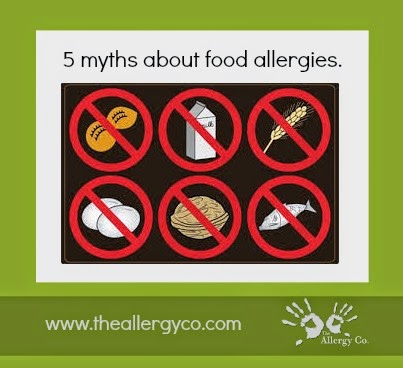Having a food allergy is scary, but being misinformed about
the facts of food allergies can lead to unnecessary anxiety and hyped fear.
Like many other health issues, lines about the truths and facts of food
allergies have been blurred by the media and so-called “experts.” As May is
Food Allergy Awareness Month, here is a closer look at the misinformation
swirling around food allergies.
Myth No. 1: Food allergy and food intolerance are the same
thing.
Fact: Although many people think they're the same, food
allergy and food intolerance describe different conditions. A food allergy is
when the body’s immune system is triggered. It can lead to mild symptoms like
hives, vomiting, diarrhea, sneezing and a running nose to more severe symptoms
like swelling of the lips, trouble swallowing, chest pain and loss of
consciousness. These symptoms usually come on quickly after someone eats a
specific food. The eight most common food allergies are milk, wheat, peanuts,
tree nuts (such as walnuts and cashews), eggs, soy, fish, and shellfish. On the
other hand, food intolerance is triggered by the digestive system. Typical
symptoms include nausea, bloating, flatulence and diarrhea. The symptoms tend
to come on gradually and occur when you eat over a tolerable limit of a food.
Common food intolerances include dairy and wheat.
Myth No. 2: Once a child is diagnosed with a food allergy,
it can never be outgrown.
Fact: Studies have shown that children can outgrow food
allergies. According to Food Allergy Research and Education, up to 20 percent
of peanut allergies and 9 percent of tree nut allergies are outgrown. Further,
wheat allergy is most common in children and is usually outgrown by the age of
3 years. Research also shows that a majority of kids with soy allergy outgrow
the allergy by the age of 10 years. This is why it is important for a child
with a food allergy to get regularly tested.
Myth No. 3: If you think you are allergic to a food, you
should stop eating it immediately.
Fact: Cutting out a suspect food from your diet without
getting properly tested for a food allergy is not advisable. Self-diagnosis can
lead to unnecessary food restrictions and lead to an unbalanced diet and
nutritional inadequacies, especially in children who need proper nutrition for
proper growth and development. Further, some people may think they have a food
allergy when they actually have another type of food disorder, and the
treatment may be different. A qualified medical professional, like a
board-certified allergist, can properly diagnose a food allergy. Common
diagnostic tests for food allergies include a skin prick test, blood test, oral
food challenge and trial elimination diet. Having a combination of tests
conducted can give you the best picture of what is really going on.
Myth No. 4: If you have a peanut allergy, smelling peanuts
can cause an anaphylactic reaction.
Fact: In order for someone with a peanut allergy to have a
severe allergic reaction (like anaphylaxis), the protein must be ingested. According
to a study published in the Journal of Allergy and Clinical Immunology,
airborne exposure – the odor – doesn’t cause an anaphylactic reaction. The
aroma (or smell) of peanuts comes from a compound in the peanuts that does not
cause an allergic reaction. If, however, you inhale peanut particles, which is
different from the peanut odor, that can lead to an allergic reaction.
Myth No. 5: Rinsing hands or tabletops with plain water is
an effective way to remove food allergens.
Fact: Rinsing hands with plain water or with antibacterial
hand sanitizer is not an effective way to remove food allergens. The same is
true with kitchen utensils and equipment. In order to effectively remove food
allergens from your hands use liquid soap, bar soap or commercial wipes. In
order to remove the food allergen from tabletops, use your common household
cleaning agents.
Sue Taylor

No comments:
Post a Comment